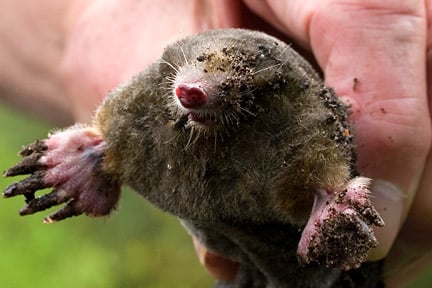
Quick facts
Common name - Mole
Scientific name - Talpa europaea
Plants affected - Lawns, flower beds and vegetable gardens
Main symptoms - Molehills
Most active - Year round
What are moles?
Moles are rarely seen as these mammals live mostly underground. They dig out a system of tunnels and chambers, and dispose of the excavated soil by throwing up molehills on the surface.
Moles don’t feed on plants, they are carnivorous feeding on invertebrates that fall into their system of tunnels. Any plant damage they cause is incidental to their lifestyle. Molehills on lawns can be removed before mowing and collapsed surface tunnels filled to maintain a level lawn surface.
Mole activity is usually greatest in late winter and early spring.
Moles are very territorial and in many cases the mole hills seen in a garden are the activity of just one individual.
Symptoms
You may see the following signs of mole activity:
- The first sign of mole activity is heaps ofexcavated soil thrown up on the surface of lawns and flower beds (molehills)
- Moles tunnelling through the soil can disturb the roots of and other small plants in flower beds and vegetable plots

Management
Where possible moles should be treated as part of the that gardens support. Should the activities of a mole be considered too disruptive there are several steps which can be taken to mitigate its activities or encourage them to move elsewhere or control moles. Additional information on living with moles from the RSPCA (Adobe Acrobat PDF).
Mole netting
Netting is available which can prevent moles coming to the lawn surface to create molehills. This must however be installed before turf is laid. This is usually made of plastic and so can add to plastic pollution.
Electronic devices
Electronic devices are available from some garden centres and mail order firms. The buzzing noise is said to drive moles away; however this may only be to another part of the garden.
Mole repellents
A type of mole-repellent smoke, sold as Pest-Stop Biofume Mole Smoke, emits castor oil fumes. These are said to line the tunnels and deter worms and other mole food from entering the tunnels. The hungry mole may move elsewhere, or it may simply create new tunnels nearby.
Planting
Caper spurge, Euphorbia lathyris, which is a plant, has its adherents who claim the root exudates repel moles. It is worth a try, but be sure to remove most of the flower heads before seeding occurs or the plant can become . of Allium moly are also sold as a mole deterrent but are of doubtful value.
Biology
Live moles are rarely seen above ground. They are about 15 cm (6 in) long, with dense blackish-brown fur and broad front paws that are adapted for digging.
The main breeding season runs from February to June, and a female will have three or four young in a nest built underground. Outside the breeding season, moles lead largely solitary lives, so all the mole activity in a small garden is likely to be due to a single animal.
Moles feed on earthworms and other soil-dwelling creatures, they do not feed on plant roots.
Image: © GWI/Nicholas Appleby. Available in high resolution at www.gardenworldimages.com











